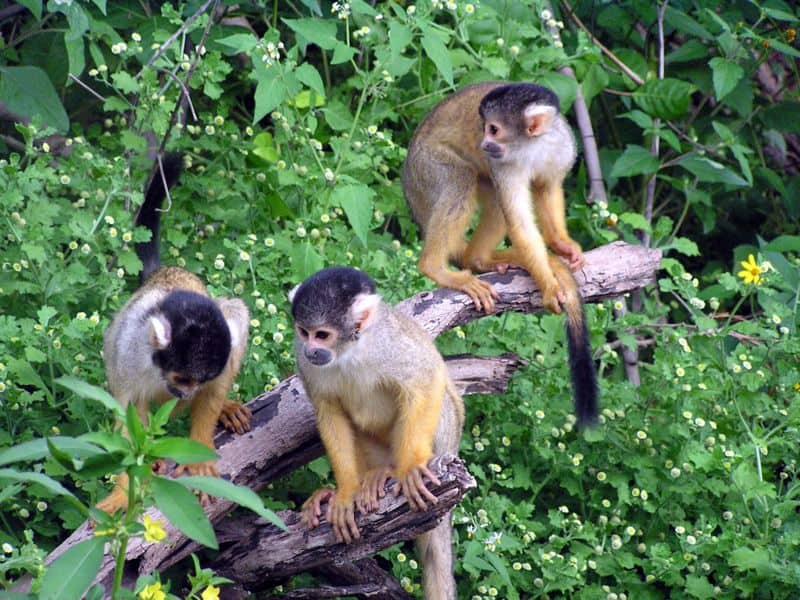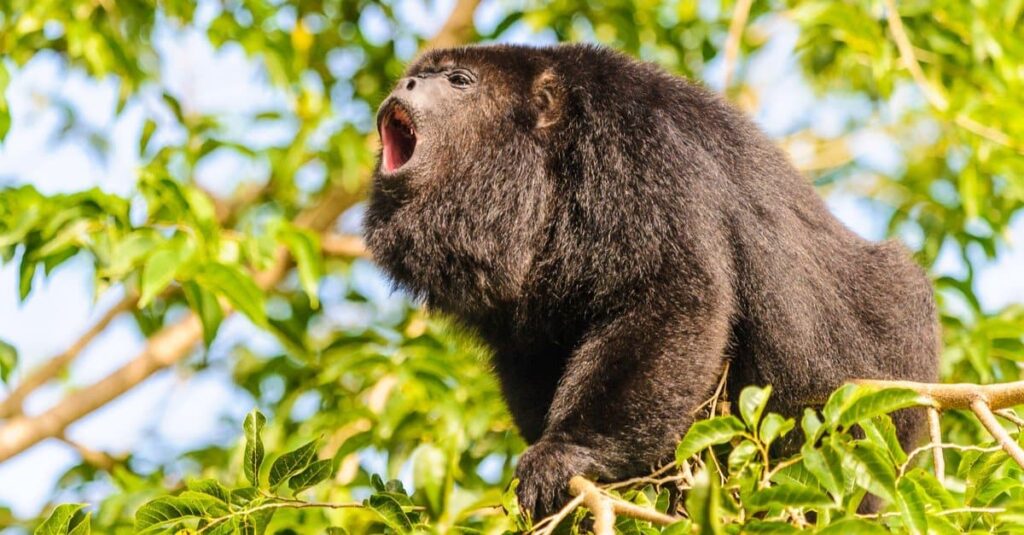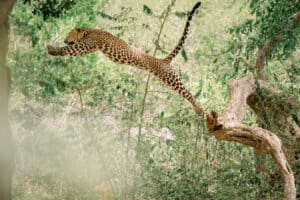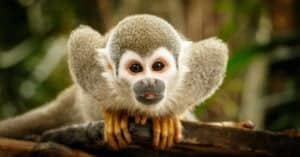Costa Rica has four native species of New World monkeys. These monkeys in Costa Rica include the Central American squirrel monkey, the Panamanian white-faced capuchin, the mantled howler, and Geoffroy’s spider monkey. Costa Rica’s indigenous monkeys typically inhabit the region’s forest areas, where they have daily access to water. They range in size, color, and behavior, making them all the more interesting. Let’s find out more about Costa Rica’s monkeys.
The Central American Squirrel Monkey
Central American squirrel monkeys are small, very intelligent, and curious. These monkeys have an orange coat covering their back, hands, and feet, with a white and black colored face. Besides, they have black rims around their eyes, noses, and mouths. Adding to their distinctive appearance, their shoulders, hips, and tails are an olive color while their bellies are white. Finally, squirrel monkeys have black caps on their heads with black tips at the end of their tails.

Monkeys in Costa Rica include the native Central American squirrel monkey, which are omnivores living in troops of 40 or more members.
©Lindadevolder assumed (based on copyright claims), CC BY-SA 3.0, via Wikimedia Commons – License
Central American squirrel monkeys live in Central Pacific Costa Rica, and western Panama. They typically occupy regions along the Pacific coast in lowland forests. In Costa Rica, you will find the Central American squirrel monkey in the Manuel Antonio National Park and Corcovado National Park. These monkeys live in troops that range from 20 to 75 members, but most groups consist of roughly 40 members.
The troops comprise a few adult males, with more adult females and infants. Central American squirrel monkeys travel up to three miles daily to forage. The troop does not split into smaller groups and sleeps in the same trees every night for months. Unlike many other monkey species, these do not have dominant hierarchies concerning females. The males generally relate well and only form dominance hierarchies during the breeding season. These monkeys are omnivorous and have a diet that includes:
Panamanian White-Faced Capuchin

Panamanian white-faced capuchins live in the forests of Costa Rica and males leave their natal groups while females do not.
The Panamanian white-faced capuchin is native to the forests of Central America. These are medium-sized New World monkeys. White-faced capuchins are primarily black with pink and white faces, as their name suggests. And while they live in Costa Rica, you will also find them in Panama, Honduras, and Nicaragua forests. The capuchins inhabit various types of forests but prefer areas with abundant water sources. Panamanian white-faced capuchins are highly intelligent and trainable to assist paraplegic persons. These monkeys use tools as weapons, reach hard-to-get-at foods, and even rub plants over their bodies as herbal medicines.
Panamanian white-faced capuchins live in troops that can be as large as 40 members. The majority of this group consists of related females. The rest of the members are unrelated and infants. Female Panamanian white-faced capuchins typically remain in their natal group. At the same time, males will leave their natal troops when they are four years old. Males will also change troops every four years. These monkeys make loud calls like barks and coughs to communicate warnings. They also use facial expressions and scents to communicate.
Panamanian white-faced capuchins are omnivores, and their diets consist of the following:
- Fruit
- Insects
- Flowers
- Leaves
- Seeds
- Beetle larvae
- Butterfly and moth caterpillars
- Ants, wasps, and their larvae
- Birds
- Birds eggs
- Frogs
- Lizards
- Crabs
- Molluscs
- Squirrels
- Parrots
- Baby coatis
Mantled Howler Monkeys

Costa Rica monkeys include the mantled howler which is a herbivorous species that creates troops of up to 20 members.
©Anton_Ivanov/Shutterstock.com
Mantled howler monkeys are indigenous to Central America and South America. These monkeys have long guard hairs on the sides of their black bodies. While plenty of fur covers their bodies, their faces are furless, and they have a naked pad on the underside of their tails. Infant mantled howler monkeys are silver to golden brown and change color at one year old. Mantled howler monkeys are new world monkeys that inhabit the forests of Costa Rica, southern Mexico, southern Guatemala, Colombia, and Ecuador.
Mantled howler monkeys live in troops of 10 to 20 members with a single dominant male. This dominant male will mate with multiple females. Mantled howler monkeys live most of their lives in trees and sleep on horizontal tree branches.
These monkeys got their name because of the way they communicate. They make loud calls by howling, barking, grunting, and woofing. They commonly howl at dusk and dawn but will also do this when disturbed. Mantled howler monkeys are herbivores, and their diets comprise the following items:
- Leaves
- Fruits
- Flowers
Geoffroy’s Spider Monkey

Geoffroy’s spider monkeys inhabit the forests of Costa Rica, have arms twice the length of their legs, and live in troops of 20 to 42 members.
©Steven G. Johnson / CC BY-SA 3.0, via Wikimedia Commons – License
Geoffroy’s spider monkey is another medium-sized new-world monkey. This spider monkey species has fur that varies in color from reddish to rust, brown, or black. They have dark hands and feet with faces that look like pale masks. Additionally, their arms are almost twice the length of their legs, and they have a strong prehensile tail that can support their entire weight. Due to their long, strong, hook-like fingers, Geoffroy’s spider monkeys are vigorous climbers and can effortlessly swing across tree branches.
Geoffroy’s spider monkeys are prevalent in the forests of Costa Rica, Panama, Nicaragua, Guatemala, Honduras, El Salvador, Belize, and south and eastern Mexico. These monkeys live in troops of 20 to 42 members. These troops frequently split into smaller groups to forage during the day. Smaller groups typically comprise two to six members that will sometimes remain alone overnight. Geoffroy’s spider monkeys communicate via barks, whinnies, squeals, squeaks, and screams. Moreover, they use barks to alert other troop members and whinnies and screams to indicate distress. Another distinctive habit is to whinny and call at dusk and dawn. These monkeys are herbivorous, and their diets consist of:
- Fruits
- Leaves
- Flowers
- Bark
- Insects
- Honey
- Seeds
- Buds
Up Next – More About Monkeys Around the World
- 9 Types Of New World Monkeys
- 10 Types Of Old World Monkeys
- Monkey Locations: Where Do Monkeys Live?
- New Monkey Alert: Just Discovered and on the Verge of Extinction
The photo featured at the top of this post is © Ludmila Ruzickova/Shutterstock.com
Thank you for reading! Have some feedback for us? Contact the AZ Animals editorial team.






